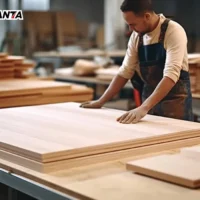How OSB is Made
OSB‘s journey from forest to frame is a carefully engineered one. The process begins with the selection and debarking of fast-growing, young trees. Softwoods are preferred because they are abundant, sustainable, and more durable. The trees are cut down, debarked and then sliced into long strands. These are the building blocks for OSB.
After the strands have been prepared, they go through a crucial phase in which they are mixed up with synthetic resins. OSB’s remarkable strength and moisture resistance are due to these adhesives. After mixing, strands of each layer are laid out perpendicularly to the next. This cross-oriented design is an important feature of OSB and contributes to its structural strength.
The layered strands will then be compressed into a dense and uniform board by applying high pressure and heat. The heat activates resin and bonds the strands together, while pressure is used to achieve the desired thickness and density. The OSB boards can be cut to size after cooling and are ready for various applications.

OSB: Benefits and Advantages
Durability and Strength: OSB’s exceptional durability and strength are among its primary benefits. The cross-oriented strands of the it provide rigidity and load bearing capacity that exceeds many other traditional materials. OSB is ideal for structural construction applications such as wall sheathing, flooring and roofing.
Resistant to Moisture: OSB is highly resistant to moisture due its integration of waxes with specialized resins. This is important for preventing mold and mildew growth, which ensures the material’s longevity in various environmental conditions.
Sustainability OSB uses young trees that grow quickly, which is a major step in the production of sustainable materials. The trees can be replenished more quickly than older hardwoods and this reduces the impact of forests. The entire tree is also used to produce it. This minimizes waste.
Versatility OSB’s adaptability is another important factor that contributes to its popularity. It is easily customizable to meet specific project requirements, whether that involves cutting it to unique shapes or changing its thickness. Its versatility is reflected in its wide range of applications, from packaging and construction to furniture manufacturing.
Cost Effectiveness: OSB is cheaper than other materials such as plywood or solid hardwood, without compromising quality or performance. Its affordability makes it a great choice for many projects, including large-scale construction and DIY home improvement.
OSB in Sustainable Construction
OSB is a key component of sustainable construction. The production process of it, which uses renewable resources to minimize waste and maximizes efficiency, is in line with eco-friendly construction goals. OSB’s durability and moisture resistance contribute to the longevity and strength of structures. This reduces the need for replacements and repair.
OSB continues to improve its environmental benefits through innovation. OSB is becoming more durable and resistant to pests and water thanks to advances in resin formulations.
The conclusion of the article is
Oriented Strand Board (OSB) is more than just a product. It’s a testimony to the potential of innovation, sustainability and efficiency within the construction and manufacturing industries. OSB is a great choice for the future, when sustainable materials will no longer be an option, but rather a necessity. Its superior strength, moisture resistance and versatility are just some of its many benefits. OSB is a key component of green building, and will continue to play an important role as we embrace this trend. It shows that high performance can be achieved without compromising our planet’s health.
















